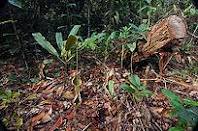|
These are interesting, frost-tender, insectivorous perennials that are mostly epiphytic (A plant that grows on trees or some other support without harming them and obtains nutrients and moisture from the air without rooting into the soil are epiphytes.). They are natives of the tropical forests of Southeast Asia, Malaya, Borneo, China and India. Some of the leaves form dangling, lidded, colored pitchers to trap and digest insects. N. hookeriana has evergreen, lance-shaped, dark green leaves. The long-lasting, pendant, pitcher-shaped flowers grow up to 5 inches long and have spurred lids. They are pale green mottled with reddish-purple. This plant grows from 24 to 30 inches high and wide. In the wild, Pitcher Plants can grow up to 60 feet long climbing up among the branches of trees or along the ground. These plants exude a honey-like secretion in the pitchers near the top. Insects are attracted to this and when they attempt to reach the nectar, slide down the slick walls of the pitcher and are caught in fluid collected at the bottom. The deceased insect is eventually digested by the plant.
Pot Cultivation
Pitcher Plants need a minimum temperature of 65 degrees. In cool climates, they are grown as house or greenhouse plants in lattice pots filled with moist bark, perlite and peat moss. The atmosphere must be humid. These plants may be grown in regular flower or orchid pots, but do best in hanging baskets. Repotting is done in January or February. The shoots should be shortened to two or three nodes (joints) and sprayed with water often. When new shoots begin to grow, take the plants out of the pots and remove the old soil by carefully rinsing in warm water. If pots are used, they are half-filled with crocks and covered with the soil mixture. Baskets don't require drainage but are lined with osmunda fiber or fibrous material from the peat. Work the compost down in-between the roots with a pointed stick. Water the plants carefully until new roots form and keep moist throughout the summer. Shade from sun at first and when the pitchers begin to develop expose to all but the harshest rays of the sun to color them. During the winter, less moisture is needed but the soil shouldn't become dry and humidity is still necessary. If allowed to grow, the stems will become several feet long and many pitchers will be produced, however, for large and perfectly formed pitchers, stop each shoot when it has formed 5 or 6 leaves.
Propagation
Seeds may be sown in the spring, or stem cuttings may be taken in the spring or summer. One-year-old shoots are taken off when they are 3 to 6 inches long. Insert the base of each cutting through a drainage hole of an inverted flowerpot. The pots are then set on a bed of peat moss in a propagating case with bottom heat of 75 to 80 degrees. Keep the case closed until roots form except to wipe the moisture off from the underside of the glass. Once they've formed roots, plant them separately in 3-inch pots, which are half-filled with crocks. The same soil for older plants is used, but chopped more finely. After potting, return them to the propagating case until they are established. When the pots are filled up with roots, transplant to larger pots or teak baskets.
 |
 |
| N. Rafflesiana |
N. Chelsonii |
Varieties
- N. albomarginata (green & red);
- N. Curtisii (crimson-purple) & var. superba;
- N. Northiana (green & red);
- N. Rafflesiana (green & red);
- N. ventricosa (red & brown);
- N. Chelsonii (crimson-purple);
- N. Balfouriana (green & crimson);
- N. Mastersiana (blood-red);
- N. mixta (cream, tinged green, blotched red);
- N. Tiveyii (green & brown);
- N. hookeriana (pale green & red-purple).
|